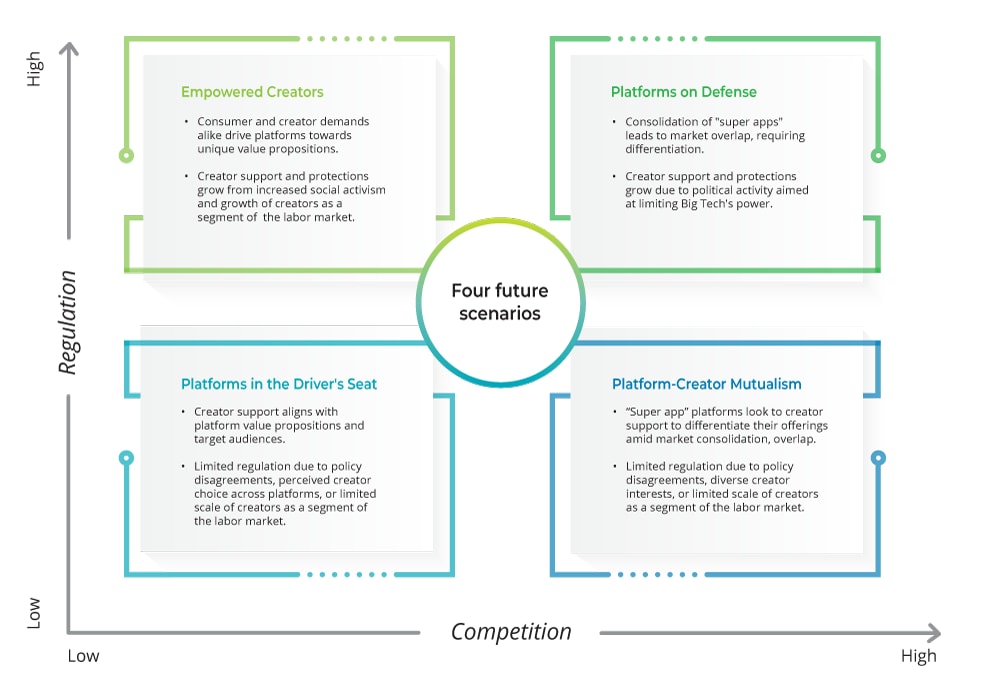Creator economy growth has been saved

Perspectives
Creator economy growth
Empowering content creators
The content creator economy isn’t just here to stay—it’s set to grow. But with continued growth comes new challenges and uncertainty. What this ecosystem looks like in the future will in part depend on the relationship between platforms and creators—and how platforms empower creators for mutual success.
Explore content
- The content creator economy
- Growing challenges
- Uncertainty amid the creator economy’s growth
- How to navigate this uncertain future
- Get in touch
The content creator economy: A global phenomenon
There is an estimated 50 million creators generating content for five billion social media users worldwide.1 Social commerce is growing rapidly and is expected to be worth $2 trillion by 2026—a projected 25% compound annual growth rate (CAGR).2 Ever since it was first dubbed the “creator economy” in 2011,3 creators and social media platforms have relied on one another, but this symbiotic relationship may be approaching a critical juncture.
Growing challenges
The growth of the creator economy sprang from the gig economy—capitalizing on the economic opportunities of platform-enabled work—but also departed from its predecessor model by empowering creators with greater individuality and agency.4 Still, the creator economy tracks with the evolution of the gig economy.5 Just as established rideshare platforms now face increased demand for transparency and fair pay, along with worker classification and protective regulatory pressure, the creator economy faces calls for a labor conversation stimulated by its growth in scale and economic impact.6
Recent Hollywood union strikes further complicate the landscape. On the one hand, they serve as a short-term economic boon for creators and platforms alike (despite risk of backlash for non-union creators who choose to work, promote, or earn income from targets of the boycott).7 On the other hand, the Screen Actors Guild and the American Federation of Television and Radio Artists (SAG-AFTRA) union strikes, coupled with broader concerns around the impact of artificial intelligence (AI), could be the spark that leads to a labor movement in the creator economy at large.
Uncertainty amid the creator economy’s growth
Cooperation and incentive alignment have always been necessary for the ecosystem to thrive, but the creator economy’s continued growth and expansion add competitive pressures and public scrutiny—introducing uncertainty on what the future might hold. While it’s hard to predict the future of any complex ecosystem, we do know that the relationship between creators and platforms will continue to evolve and will likely be shaped by three macro forces:
- Competition
- Government policy
- Corporate social responsibility
How to navigate this uncertain future
Amid such uncertainty, scenario planning can be an effective tool to explore possible futures, stretch thinking, and chart a new course. To help make sense of how the relationship between platforms and creators could evolve in the future—and to what extent it might follow gig economy or workforce ecosystem trends at large—we’ve used the two factors from the previous section, competition and policy, to explore four potential futures. These four futures are not exhaustive, or meant to be positive or negative, or likely to manifest as all-or-nothing. Rather, they’re meant to facilitate sense-making by helping social platforms, creators, and governing bodies reflect on the nature of this ecosystem to determine the right path forward.

Explore the four scenarios further and learn how to maximize opportunities—download the full report.
Endnotes
1 Andy Karuza, “Make the most of the creator economy,” Forbes, July 18, 2022.
2 Brooke Auxier et al., “As seen in your feed: Shopping goes social, trending past US$1 trillion in annual sales,” Deloitte, November 30, 2022; Deloitte, “Social commerce and the creator economy: Business model considerations for the ecosystem,” accessed September 19, 2023.
3 Kyle Chayka, “What the ‘creator economy’ promises—and what it actually does,” New Yorker, July 17, 2021.
4 Li Jin, “The passion economy and the future of work,” Andreessen Horowitz, October 8, 2019.
5 Ibid.
6 Oxford Economics, The state of the creator economy: Assessing the economic, cultural, and societal impact of YouTube in the US in 2022, 2022; Li Jin, Scott Duke Kominers, and Lila Shroff, “A labor movement for the platform economy,” Harvard Business Review, September 24, 2021; Jin Li, “The creator economy is in crisis. Now let’s fix it,” Li’s Newsletter, August 10, 2021; Created Economy Podcast, “Created Economy 055: Interview with Kaya Yurieff (The Information),” September 20, 2022.
7 Drew Harwell and Taylor Lorenz, “The creator economy was already exploding. Then Hollywood went on strike,” Washington Post, July 7, 2023.
Recommendations
The Creator Economy in 3D
This report covers how the content creator economy is changing consumer engagement with brands, media, and buying channels.




